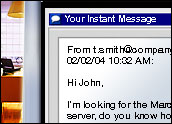
In the ultimate game of bait-and-switch, several Web sites try to pass off a bot as a bod. That is to say that Live Chat is offered to users, but there’s no flesh-and-blood person on the line, there’s only a chat bot making a robotic guess at what the user might want to know. Few are fooled by the switcheroo, but nonetheless, could the tactic be working?
“Ask me again when somebody devises one that passes the Turing Test,” David Dingley, senior analyst for PhoCus Wright, told CRM Buyer. “Until then, it is amusing, no more. A good FAQ and search tool produces a better service.”
The Turing Test, made famous in “2001: A Space Odyssey,” attempts to distinguish between a human and a machine and is considered the benchmark for artificial intelligence.
Half Incorrect, Half Wrong
One only has to get an unrelated answer once from a chat bot to know that things aren’t likely to get any better throughout the exchange. Yet the bots are billed as “artificial intelligence” capable of improving over time. So the question remains: Will these things ever learn?
“An ideal chat bot can understand everything the user is trying to say or do, and help her,” Harshal Deo, senior manager of applied research at eBay, told CRM Buyer. “But the real-world app should start from a few basic steps. Say, try to route the user to the proper customer rep or help page. Basically pick a small function and try to ‘learn’ to support that.”
Say What You Mean
Some say a few of these tools are already there.
John Ragsdale, former Forrester Research analyst who is currently with the Service & Support Professionals Association, touted advancements in chat bots and their recent resurgence in popularity in his blog recently.
He cites antiquated “answer pairs” technology as being at the root of unsatisfactory chat bot performance, but says the advent of natural language search (NLS) engines such as those employed by European powerhouse Q-go discern the intent of the question rather than simply matching keywords. In other words, NLS figures out what we mean as opposed to what we said in the text block.
NLS is certainly a hot button in search these days, as is the related Semantics, but it’s yet to make a dent on U.S. soil. In Europe, however, Q-go is a hit.
Q-go answered more than 650,000 customer questions in its first year (presumably correctly), and customer adoption is growing every week, Ragsdale says. He even predicts Q-go will soon be applied to e-mail and voice mail.
That of course, begs the question of whether AI-based chat bots will eventually replace human interaction completely.
“In the future this may be possible, but I still think we’re a ways away from it yet,” Jason Schutte, an account representative at The Frantz Group, told CRM Buyer. “To be completely honest, with all the chat rooms, forums and bulletin boards available, I don’t see this being a real alternative to human interaction any time in the near future.”
Others in the field see a big problem in AI “learning” abilities. “Newer systems use a natural language search function to help the system identify the intent of the user, but, to date, there have not been any solutions that learn over time, or do a good job of tailoring their answers based on context,” John Federman, CEO of customer contact enabler eStara, told CRM Buyer.
Looking in All the Wrong Places
Perhaps the problem lies in the attempt to totally replace humans. “The biggest problem with the chat bots is the same as is found in many AI/machine learning solutions: They try to find the 100 percent perfect solution,” says Deo.
Another common problem with AI, according to Deo, is the huge gap between scientists who are designing the math and science behind it and the application people who can apply that.
“The scientists are after pure algorithms to increase accuracy. But in the real world one can apply that differently,” he warns.
For example, scientists would try to perfect algorithms to “learn” what the user is saying based on what she types. However, a real world app could use the context such as what pages did the user visit? What is the history of user’s transactions? Then, it would augment these data to the questions to build more applied learning.
Half and Half Is Wholly Right
While to err is human, it is generally unacceptable in all things computer enhanced. That’s why some are saying a part human, part bot (a bod-bot maybe?) response might be the better solution.
“One instance where we do see automated chat put to good use is on 1-800-Radiator’s Web site,” says Federman. “The company recognized that it had a much better chance of converting customers over the phone than online, so it used an automated chat service to pre-qualify customers, gather information and then escalate the contact to the phone via click to call.”
Federman says Radiator.com was able to scrape the information from the chat session and deliver it to its contact center agents the second the call was connected, so the context of the online session was readily available to the customer service representative. “This approach increased sales conversion by 35 to 40 percent, according to executives at Radiator.com,” he says.
Rather than try to force the chat bot to do more than it could handle, the company leveraged the chat bot’s strength (gathering information) to create a much more personalized experience for the consumer once they made contact by phone.
At the end of the day, the real intelligent decision is to simply pick the right tool for the job at hand.
“If the goal is to generate sales and improve service efficiency, we suggest empowering live chat agents with tools that allow them to leverage automated and canned responses,” advises Federman. “However, it should be left to the agent to decide when it’s most appropriate to issue a canned response or when a customer’s inquiry requires a more personal touch.”






















































